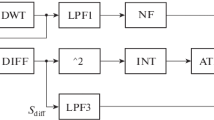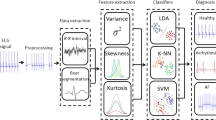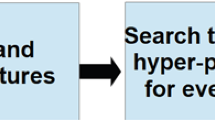Abstract
Automatic interpretation of electrocardiograms provides a noninvasive and inexpensive technique for analyzing the heart activity of patients with a range of cardiac conditions. We propose a method that combines locally weighted linear regression with nearest neighbor search for heartbeat detection and classification in the management of non-life-threatening arrhythmia. In the proposed method, heartbeats are detected and their features are found using the Pan–Tompkins algorithm; then, they are classified by locally weighted linear regression on their nearest neighbors in a training set. The results of evaluation on data from the MIT-BIH arrhythmia database indicate that the proposed method has a sensitivity of 93.68 %, a positive predictive value of 96.62 %, and an accuracy of 98.07 % for type-oriented evaluation; and a sensitivity of 74.15 %, a positive predictive value of 72.5 %, and an accuracy of 88.69 % for patient-oriented evaluation. These results are comparable to those from existing search schemes and contribute to the systematic design of automatic heartbeat classification systems for clinical decision support.




Similar content being viewed by others
Explore related subjects
Discover the latest articles, news and stories from top researchers in related subjects.References
AAMI (1998) Testing and reporting Performance results of cardiac rhythm and ST-segment measurement algorithms. Association for the Advancement of Medical Instrumentation, ANSI/AAMI Std. EC57:1998
Acampora G, Lee C-S, Vitiello A, Wang M-H (2012) Evaluating cardiac health through semantic soft computing techniques. Soft Comput 16:1165–1181
Almeida R, Martínez JP, Olmos S et al (2003) Automatic delineation of T and P wave using a wavelet-based multiscale approach. In: Presented at the international congress on computational bioengineering, Espan̄a
Atkeson CG, Moore AW, Schaal S (1997) Locally weighted learning. J Artif Intell Rev 11:11–73
Belgacem N, Bereksi-Reguig F (2011) Bluetooth portable device for ECG and patient motion monitoring. Nat Technol 4:19–23
Ceylan R, Özbay Y, Karlik B (2009) A novel approach for classification of ECG arrhythmias: type-2 fuzzy clustering neural network. Expert Syst Appl 36:6721–6726
Chiarugi F, Emmanouilidou D, Tsamardinos I (2010) The morphological classification of heartbeats as dominant and non-dominant in ECG signals. Physiol Meas 31:611–631
D’Angelo LT, Tarita E, Zywietz TK et al (2010) A system for intelligent home care ECG upload and priorisation. In: Presented at the 32nd international conference of the IEEE engineering in medicine and biology society, Minneapolis
de Chazal P, O’Dwyer M, Reilly RB (2004) Automatic classification of heartbeats using ECG morphology and heartbeat interval features. IEEE Trans Biomed Eng 51:1196–1206
de Chazal P, Reilly RB (2006) A patient-adapting heartbeat classifier using ECG morphology and heartbeat interval features. IEEE Trans Biomed Eng 53:2535–2543
de Lannoy G, Francois D, Delbeke J et al (2012) Weighted conditional random fields for supervised interpatient heartbeat classification. IEEE Trans Biomed Eng 59:241–247
de Oliveira LSC, Andreo RV, Sarcinelli-Filho M (2011) Premature ventricular beat classification using a dynamic Bayesian network. In: Presented at the 33nd international conference of the IEEE engineering in medicine and biology society, Boston
Gacek A, Pedrycz W (2013) Description, analysis, and classification of biomedical signals: a computational intelligence approach. Soft Comput 17:1659–1671
Hall M, Frank E, Holmes G, Pfahringer B, Reutemann P, Witten IH (2009) The WEKA data mining software: an update. SIGKDD Explor 11:10–18
Haseena HH, Mathew AT, Paul JK (2011) Fuzzy clustered probabilistic and multi layered feed forward neural networks for electrocardiogram arrhythmia classification. J Med Syst 35:179–188
Hu YH, Palreddy S, Tompkins WJ (1997) A patient-adaptable ECG beat classifier using a mixture of experts approach. IEEE Trans Biomed Eng 44:891–900
Jadhav S, Nalbalwar S, Ghatol A (2014) Feature elimination based random subspace ensembles learning for ECG arrhythmia diagnosis. Soft Comput 18:579–587
Ko SY, Wang KM, Lian WC et al. (2012) A portable ECG recorder. In: Presented at the 2nd international conference on consumer electronics, communications and networks, Yichang
Lagerholm M, Peterson C, Braccini G et al (2000) Clustering ECG complexes using Hermite functions and self-organizing maps. IEEE Trans Biomed Eng 47:838–848
Llamedo M, Martinez JP (2011) Heartbeat classification using feature selection driven by database generalization criteria. IEEE Trans Biomed Eng 58:616–625
Mitchell TM (1997) Machine Learning. McGraw-Hill, Boston
Moody GB, Mark RG (2001) The impact of the MIT-BIH arrhythmia database. IEEE Eng Med Biol Magaz 20:45–50
Osowski S, Hoai LT, Markiewicz T (2004) Support vector machine-based expert system for reliable heartbeat recognition. IEEE Trans Biomed Eng 51:582–589
Pan J, Tompkins WJ (1985) A real-time QRS detection algorithm. IEEE Trans Biomed Eng 32:230–236
Park J, Kang K (2014) Intelligent classification of heartbeats for automated real-time ECG monitoring. Telemed e-Health. 20:1069–1077
Park J, Lee K, Kang K (2013) Arrhythmia detection from heartbeat using k-nearest neighbor classifier. IEEE international conference on bioinformatics and biomedicine, Shanghai
Prasad GK, Sahambi JS (2003) Classification of ECG arrhythmias using multi-resolution analysis and neural networks. In: Presented at the international conference on convergent technologies for the Asia-Pacific region, Bangalore
Rodriguez J, Gon̄i A, Illarramendi A (2005) Real-time classification of ECGs on a PDA. IEEE Trans Inf Technol Biomed 9:23–34
Singh YN, Gupta P (2011) Correlation-based classification of heartbeats for individual identification. Soft Comput 15:449–460
Tello PJP, Manjarres O, Quijano M et al (2012) Remote monitoring system of ECG and temperature signals using Bluetooth. In: Presented at the IEEE symposium on information technology in medicine and education, Hokodate
Vohavi R (1995) A study of cross-validation and bootstrap for accuracy estimation and model selection. In: Presented at the international joint conference on artificial intelligence, Montreal
Ye C, Kumar BVKV, Coimbra MT (2012) Heartbeat classification using morphological and dynamic features of ECG signals. IEEE Trans Biomed Eng 59:2930–2941
Yeap TH, Johnson F, Rachniowski M (1990) ECG beat classification by a neural network. In: Presented at the international conference of the IEEE engineering in medicine and biology society, Philadelphia
Zhang L, Peng H, Yu C (2010) An approach for ECG classification based on wavelet feature extraction and decision tree. In: Presented at the international conference on wireless communications and signal processing, Suzhou
Acknowledgments
This work was partly supported by the MSIP (Ministry of Science, ICT and Future Planning), Korea, under the ITRC (Information Technology Research Center) support program (IITP-2016-H8501-16-1018)) supervised by the IITP (Institute for Information & communications Technology Promotion), and partly supported by IITP grant funded by the Korea government (MSIP) (No. B0101-15-0557, Resilient Cyber-Physical Systems Research).
Author information
Authors and Affiliations
Corresponding author
Ethics declarations
Conflict of interest
No competing financial interests exist.
Additional information
Communicated by V. Loia.
Rights and permissions
About this article
Cite this article
Park, J., Bhuiyan, M.Z.A., Kang, M. et al. Nearest neighbor search with locally weighted linear regression for heartbeat classification. Soft Comput 22, 1225–1236 (2018). https://doi.org/10.1007/s00500-016-2410-9
Published:
Issue Date:
DOI: https://doi.org/10.1007/s00500-016-2410-9




